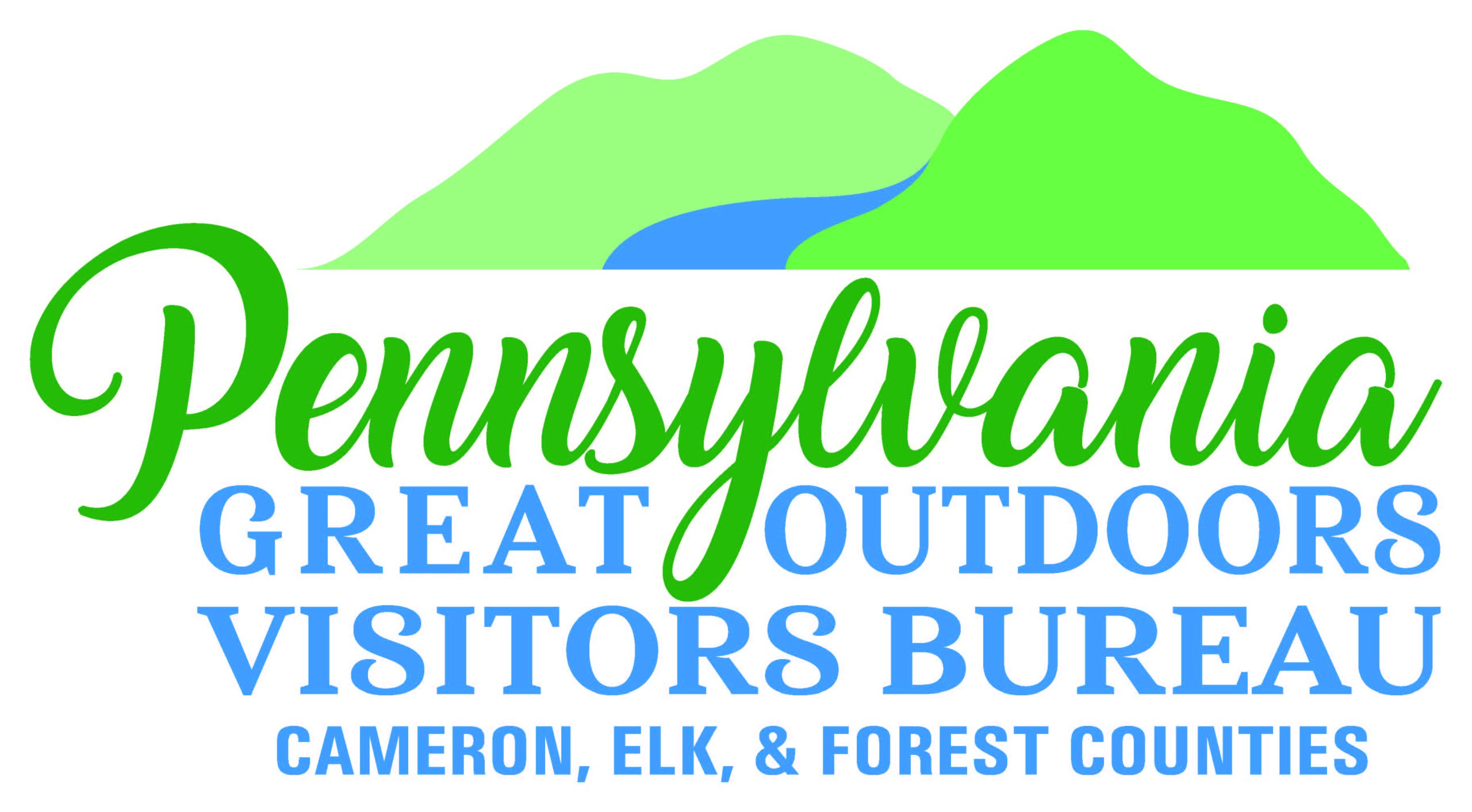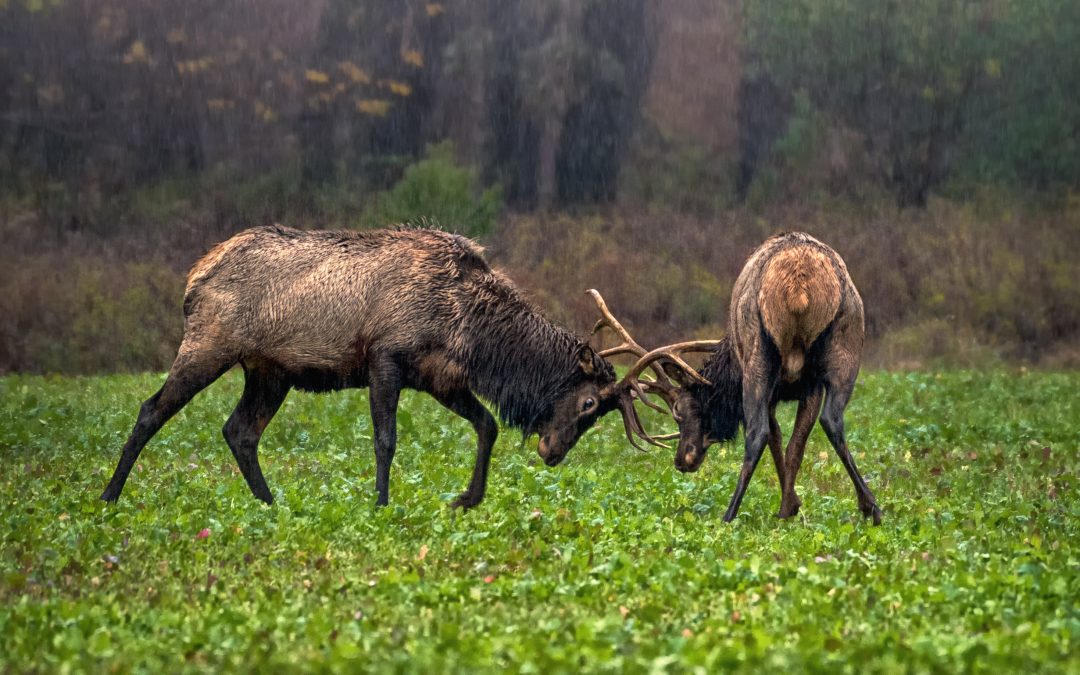Written by Danielle Taylor | Header photo by Rehna George

A bull elk bugles for mates. Photo by Tina Blackwell.
Autumn signals the annual mating season for Pennsylvania’s wild elk, and it’s one of the most exciting times of the year to see these magnificent creatures in person. These powerful animals can measure nine feet tall from hoof to the tip of their antlers and weigh more 800 pounds, and Pennsylvania’s Elk Country is home to about 1,000 wild elk that roam freely through the mountains and valleys of Elk and Cameron Counties. Any time of year, you can take a drive through and around Benezette to catch sight of them. However, during the mid-September to mid-October “rut,” or mating period, you can hear bulls (male elk) bugling as they call for cows (female elk) and claim their territories, and you can watch as the bulls engage in violent clashes in their attempt to take over each other’s “harems,” or groups of cows gathered for mating. It’s a thrilling phenomenon to see and hear, and it’s not one you’ll forget anytime soon.
Elk are generally most active around dawn and dusk as they move from feeding in the open fields to sheltered woodlands, but they spend a lot more time out in the open fields during the rut. As you explore Elk Country, watch for a herd of cows being guarded by a dominant bull. If you don’t see anything right away, just listen for a few minutes. You might hear bulls bugling, pawing the ground, or crashing their antlers together in the midst of battle. To get a taste of what you can find in person, check out the Pennsylvania Game Commission’s live elk cam, which will offer a live feed from Elk Country for the next several weeks.

During the rut, elk cows and calves gather in harems, and bulls fight for dominance of these groups. Photo by David Schmude.
Elk Chemistry
A number of complex biological and social factors come together to cause the rut each autumn. “The physiology behind the rut is changing hormone levels (mainly testosterone), which is triggered by photo-period or day length,” says Jeremy Banfield, Pennsylvania Game Commission elk management wildlife biologist. “As the days begin to shorten in the fall, increases in testosterone induce the breeding behaviors.”
Elk cows and calves tend to stay grouped together throughout the year, but during the rut, bulls join into the mix and aggressively guard herds they have claimed as theirs. In Pennsylvania, cows outnumber bulls by approximately three to one. When one bull approaches to challenge another, the two size each other up, and although they often avoid direct contact, tensions can escalate quickly.
“Fights can be spontaneous (at least from our human perspective) and intense,” Banfield says. “They are usually brief under most circumstances but can last several minutes before a clear victor is apparent.” With sharp hooves and antlers and a lot of pent-up aggression, the bulls can severely injure each other during these battles, and sometimes it even leads to death. Banfield notes that they usually find at least one fallen elk each year. “Estimating for those that we don’t find, I would conservatively say between five and eight bulls will die from combat-related injuries annually.”
Safe and Respectful Viewing Tips
Banfield stresses that anyone coming to Elk Country to see the elk, particularly during the rut, needs to follow a few guidelines to ensure safety for themselves and other people as well as the elk. “They are wild animals and unpredictable,” he says. “The levels of testosterone in the bulls’ blood increases significantly, so they are hyperaggressive.” Pennsylvania Game Commission guidelines note that observers should stay at least 100 yards away, stating “If you cause the animal to move, you are too close.”
The excitement of seeing these massive, powerful animals in the wild sometimes causes viewers to forget basic traffic safety rules, but vehicles are just as dangerous as the elk. When you see elk and want to stop, pull your vehicle completely off the roadway, or watch from one of several designated elk viewing areas listed below.
Also, much of Elk Country is privately owned, and trespassing laws apply here just like anywhere else. As you watch elk and other wildlife, respect private property. If they move to an area you can’t legally access, move on and find other groups to view.
Finally, as much as you may want to entice elk to come to you by putting out food, doing so is illegal under Pennsylvania commonwealth law. Check out this blog post to learn more.

A life-size bull elk statue greets you outside the Elk Country Visitor Center.
Best Viewing Spots
Elk Country Visitor Center
In Elk and Cameron Counties, there are several viewing areas you can visit to see wild elk. The top spot for observing elk is the Elk Country Visitor Center in Benezette, the heart of the elk range. The 245 acres around the center have specially planted forage plots that attract elk and other wildlife as well as viewing blinds, walking paths to explore, and horse-drawn wagon rides around the property.
Inside the center, you will find TV screens with live camera feeds of wildlife runs near the center. There are also interactive exhibits and a 4D sensory surround-sound theater that provides fascinating facts about the Pennsylvania wild elk herd.
The center itself is open from 8 a.m. to 8 p.m. daily in September and October. You can enjoy the center’s outdoor observation areas every day starting at dawn. In November and December, the center is open Thursday through Monday, 9 a.m. to 5 p.m. The Elk Country Visitor Center is located at 134 Homestead Drive in Benezette, but use 950 Winslow Hill Road for GPS navigation.
Elk Scenic Drive and Hicks Run Viewing Area
The picturesque Elk Scenic Drive along Route 555 follows the Bennett Branch of Sinnemahoning Creek from Weedville to Driftwood. En route, you’ll find many park-and-view sites designed for safe and easy elk watching. The sites have been chosen for their outstanding wildlife viewing and scenic beauty. Also along the way, you’ll come across the Hicks Run Viewing Area, which features a covered, handicap-accessible viewing blind that allows you to watch elk undetected as they feed on the rich food plot planted there. The site offers off-road parking and information kiosks featuring intriguing facts about Pennsylvania’s wild elk.

Viewing blinds like this one at Hicks Run help hide curious humans from wildlife, making it possible to see them up close if they approach.
Dents Run Elk Viewing Area
Convenient parking, magnificent views, four fields, and acres of wooded area frequented by the wild elk herd make Dents Run Elk Viewing Area one of the most popular elk viewing spots in Pennsylvania. Travelers who stop in will also find a visitor center, covered stage, benches, bathrooms, and handicap parking. To reach this location, head north on Winslow Hill Road off Route 555 for 3.5 miles. The Dents Run Elk Viewing Area will be located on the right.
Sinnemahoning State Park
At this 1,900-acre park in eastern Cameron County, look for elk near the 40 Maples Picnic Area and designated wildlife viewing area. The grassy opening near the viewing platform has been planted with clover and trefoil, two favorites of elk and other wildlife.
Sinnemahoning State Park is located eight miles north on Route 872 from its junction with Route 120 in Sinnemahoning and is surrounded by the Elk, Susquehannock, and Sproul State Forests. At the northern tip of the park, you’ll find a state-of-the-art Wildlife Center, which features a gallery of interactive nature exhibits as well as maps and information about the region.
Bucktail State Park Natural Area
This natural area features a winding 75-mile scenic drive along Route 120 from Emporium to Lock Haven through unspoiled forestlands, beautiful hills, and deep valleys. Throughout autumn, enjoy breathtaking views of fall foliage as well as wild elk on the move.
Quehanna Wild Area
Spanning through Cameron and Elk County, the Quehanna Wild Area covers more than 40,000 acres of prime elk viewing landscape. This area is also home to the Quehanna Trail, a 75-mile loop that passes through Moshannon and Elk State Forests, and it journeys past many small and beautiful waterfalls you won’t want to miss. You can also find the Marion Brooks Natural Area here, home to one of the largest stands of white birch trees in the northeast. If you’re interested in “getting back to nature,” this trail is the most direct route.
 Elk Viewing Guide
Elk Viewing Guide
Before you head out on your elk viewing adventure, be sure to grab a free Pennsylvania Great Outdoors Elk Viewing Guide for a complete directory of the best locations for prime elk watching, tips on what times and seasons you’re most likely to spot the elk, and listings for lodgings, restaurants, and other businesses that cater specifically to Elk Country visitors. Get yours at VisitPAGO.com/Free-Information, at the Pennsylvania Great Outdoors Visitor Center at 2801 Maplevale Road in Brookville, at the Elk Country Visitor Center, or at one of more than 150 lodging facilities, rest stops, restaurants, attractions, and other tourism-focused destinations throughout Jefferson, Elk, Clarion, Cameron, and Forest Counties.
 A version of this article originally appeared in the Fall/Winter 2018 issue of GO magazine, which contains feature articles, photos, travel tips, upcoming events, lodging listings, and more information on Jefferson, Elk, Clarion, Forest, and Cameron Counties in northwestern Pennsylvania. To get your FREE copy of this or any other publication by the Pennsylvania Great Outdoors Visitors Bureau, click here and enter your information or call (814) 849-5197.
A version of this article originally appeared in the Fall/Winter 2018 issue of GO magazine, which contains feature articles, photos, travel tips, upcoming events, lodging listings, and more information on Jefferson, Elk, Clarion, Forest, and Cameron Counties in northwestern Pennsylvania. To get your FREE copy of this or any other publication by the Pennsylvania Great Outdoors Visitors Bureau, click here and enter your information or call (814) 849-5197.

















